Some History on Hearing, Workplace Noise and Instrumentation
Walter Montano, Technical Department, Arquiust, Gualeguaychu, Argentina
Introduction
This is the third in a series of articles published by the author in Noise/News International, dealing with particular historical aspects of concerns about noise. This article will focus on the early concerns about noise in workplaces, a topic first presented in 1910 at a meeting of the International Labour Organization (ILO). A century later the author was able to obtain a digital copy of the first encyclopedia published by ILO and which identifies noise problems for workers at workplaces and the early treatments by an Italian doctor. As for the previous articles, this article provides a summary of the technological advances over the decades.
The International Commission on Occupational Health (ICOH)
The Internal Commission on Occupational Health was founded in 1906 in Milan as the Permanent Commission on Occupational Health, and “ICOH is recognized by the UN as an NGO and has close working relationships with ILO and WHO” (ICOH, 2020), according to its official website. Also, The International Commission on Occupational Health (ICOH) is an international non-government professional society whose aims are to foster the scientific progress, knowledge, and development of occupational health and safety in all its aspects.”
There is little information on the 1st ICOH conference but The Times, September 29, 1910, reported on the 2nd ICOH Congress, held in Brussels. Dr. Alfred Peyser (1870-1955), in his paper on “Industrial diseases and injuries of the auditory system” (in German), proposed that the “Congress should instruct a commission to systematically study occupational diseases of the hearing system and present a report at the next session.”
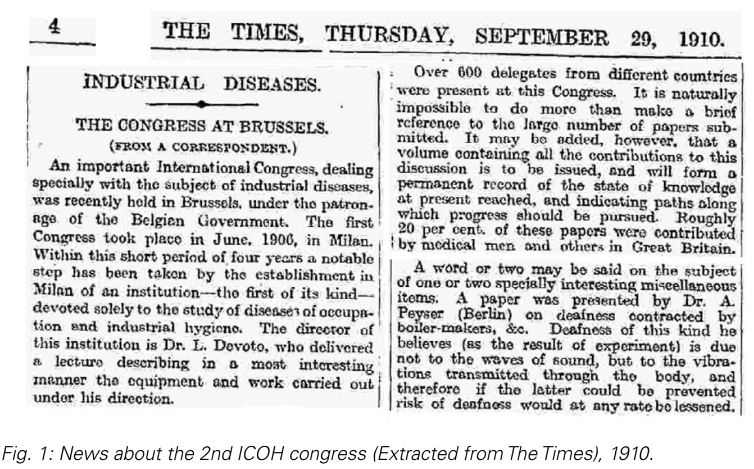
His study was on deafness contracted by boilermakers, with statistics from experimental data, demonstrating that “Continuous noises of medium intensity, transmitted exclusively through the air, have a harmful influence on the hearing apparatus, or at least this influence is weak. He also added “Short and loud noises or noises of a very high pitch produce, particularly when repeated, temporary or lasting damage to the hearing system;” and the most important finding on his investigation was “The propagation of noise through the skeleton, especially through the ground, end up creating very serious damage to the hearing system.” (Peyser, 1910).
At the end of this article by Peyser a summary in French condenses his entire proposal for actions intended to protect people from injuries due to noise exposure:
Prophylaxis of hearing damage in Industry 1. Exclusion of works with lesions of the ear, nervous system, anemia.2. Introduction of rest time with noise suppression, or reduction of working hours. In jobs that pose the greatest threat to the hearing system, rotate workers from 15 to 15 to 30 to 30 minutes. 3. Construction of workers’ houses away from all noise.4. Placement of devices intended to muffle noise and reduce trepidations. 5. Periodic otological inspection of workers. (Peyser, 1910)
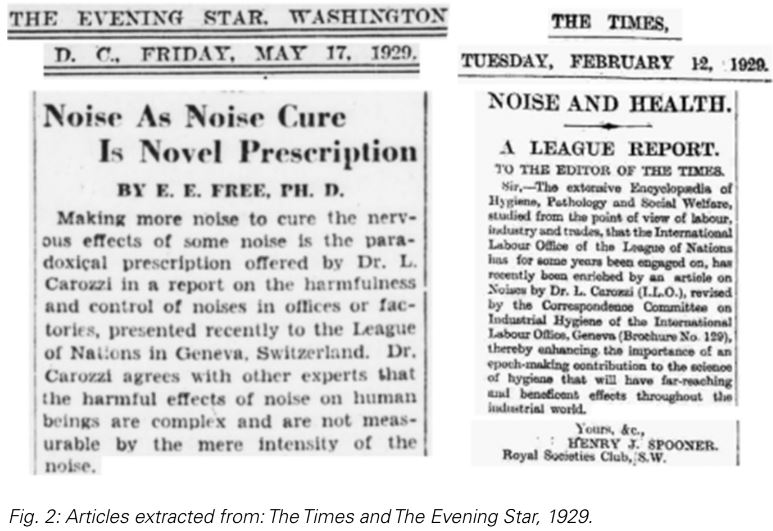
International Labour Organization and Noise
The International Labour Organization (ILO) “was created in 1919, as part of the Treaty of Versailles that ended World War I, to reflect the belief that universal and lasting peace can be accomplished only if it is based on social justice;” the constitution of the ILO was a “process resulted in a tripartite organization, the only one of its kind, bringing together representatives of governments, employers and workers in its executive bodies,” finally in 1946 the ILO became a specialized agency of the United Nations (ILO, 2020).
According to internal documents, ILO started to prepare to publish an encyclopedia of industrial hygiene around 1925. Dr Luigi Carozzi was one of those responsible for developing the content. The sections were written by many collaborators and were presented separately to the Board. ILO then published the first version of “Occupation and Health – Encyclopaedia of Hygiene, Pathology and Social Welfare” in two volumes: Volume I A-H, in 1930; Volume II I-Z, in 1934.
Luigi Carozzi and his work about occupational noise
In 1929, an Italian doctor, Luigi Carozzi (1880-1963) chief of the Hygiene service at ILO (also a member of ICOH board), presented an original text which described several diseases at workplaces, including the noise problems, however, there are no official documents at the ILO archive on his early notes.
Unfortunately, there are only a few isolated articles available on the Internet about Carozzi’s work on noise problems. Two comments and explain the Carozzi’s Report so-called “Correspondence Committee on Industrial Hygiene of the ILO (Brochure No 129)”: (a) The Times of London of February 12, 1929, in “Letter to editors” written by Henry J. Spooner (1856-1940). In this, he highlights some of Carozzi proposals “it is a consolation that long last the devastating effects (both hygiene and economic) of harmful noise are receiving international attention,” adding “These and many other considered opinions of the distinguished author, fathered by the correspondence Committee, cannot fail to command the serious attention of the authorities and others responsible for the health of workers of all nations;” (b) The Evening Star of Washington on May 17, 1929, published an article “Noise as noise cure is novel prescription” written by Edward Elway Free (1883-1939).
Some background on Spooner who reported Carozzi’s work (Fig. 2): He was a worldwide well-known English mechanical engineer and acoustician who had a strong sense of the problem of noise on people’s health. He said, “and a careful perusal of the comprehensive brochure referred to should inspire them to energize in tackling the manifold problems of noise reduction in all activities, in the great cause of humanity; realizing that mechanical noise connotes wicked waste, and too often unskillful design and construction; also that ignorance of the harmful effects of noise and vibrations on the human-machine is the most general cause of inaction.” As an example of his beliefs, Spooner helped the “Manufacturing Grocers” Union of Australia, in 1924 to a demand on employers that “All mills and machines shall be run with as little noise as possible,” as the States Secretary quoted (Recorder, 1928). Spooner suggested in January 1922 having a ‘Day of silence,’ being this the first time that an acoustician proposed a social activity to promote the problems for human health resulting from noise.
The section “Noises” in the first ILO Encyclopedia
The second volume of the “Occupation and Health – Encyclopaedia of Hygiene, Pathology and Social Welfare” included the diseases starting with I-Z was published in 1934. The introduction of the five pages of the chapter “Noises,” written by Carozzi, is a clear declaration of the importance of noise control at workplaces:
The influence of noises on the health of workers is one of the most important problems of industrial pathology, for it concerns nearly every modern industry. As a matter of fact, there are few industries to which the introduction of machinery has not brought, in addition to radical changes in methods of work, more or less serious disadvantages from noise and vibration. The study of industrial noises is of comparatively recent date, and the increasing interest which it arouses is accounted for partly by the increase in industrial noises, and partly by a better realization of their harmful effect, and of the waste of energy which they cause. (ILO, 1934, p.365)
He uses Peyser’s research (the one presented at 2nd ICOH) about the classification of the different sources of noise in workplaces and also discusses that vibration transmitted through the body could cause deafness (depending on the amount of the mechanical energy). It is interesting that Carozzi put emphasis on young workers because “they are more exposed to get deafness” and “The age of the sufferer must be taken into consideration with the increase of lesions…” (ILO, 1934, pp.366-367). He proposed rational efforts to diminish the harmful effect of noises, by suppression or diminution of noises and vibrations at the source, and suggested “the use of acoustic material to reduce the airborne sound transmission,” and to put “bases of special materials or on special foundations, independent of the floor used by personnel, or enclosing them in special rooms” (ILO, 1934, p.370).
Although the encyclopedia was published in 1934, when discussing the technology that should be used to analyze the noise inside the workplaces, the methods and acoustic instrumentation that he proposes are those available prior to 1925. For example, he does not mention the noise meters that were used worldwide from 1926 and he proposes to use Edison’s phonograph, tuning forks and oscilloscopes, and even Low’s “audiometer”.
Section “Industrial noise (Physio-pathology)” in Supplement of the ILO’s Encyclopedia
In 1938 ILO published an updating supplement for the Encyclopedia which included a ten-page chapter on “Industrial noise (Physio-pathology)” was written by Dr. Raoul Caussé (1892-1949) (ILO, 1938, pp.107-117).
The first chapter Definition, measurement, and analysis of noise present the metrological definitions from “The first international acoustical conference” held in Paris in July 1937 under the auspices of the International Electrotechnical Commission (IEC), with the cooperation of the Comité Consultatif International Téléphonique (CCIT), and also the Federation of National Standardising Bodies known as the International Standard Association (the former ISO) (Nature, 1937). This is important because the ILO adopted the use of standardized sound meters. Caussé also mentions the use of the Barkhausen noise meter as a possible analyzer of noise levels in workplaces and it was being used for this purpose in Germany (Beck & Holtzmann, 1929).
The second chapter Influence of noise on the system explains the harmful effect of noise on the ear, presenting a short timeline of the history of what physicians have discovered. The third chapter, Types of occupational deafness, offers a scientific justification about the existence of occupational deafness can no longer be doubted and presents an analysis of one survey made in New York in 1930 into the effect of noise on the hearing of industrial workers. Chapter four on Noisy trades states that “there were no classifications of industries based on an objective photometric study of noise,” and so provides a ranking of noisy trades. Chapter five on Prophylaxis presents some observations on occupational deafness. Legislation is the last chapter where a complete summary of policies on workplace noise from different countries; Caussé presents his view that although “For some years past public interest has been directed to what is known as the campaign against noise, and regulations which are often extremely stringent have been issued in an effort to restrict noise,” he adds “It should, however, be observed that industrial noise or harmful noise is not in question here, but solely street noises or noises inside buildings, which are mere of a disturbing character.” In conclusion, Caussé highlighted the importance of the compensation for deafness: “Age must be taken into account, since it contributes, especially after the age of 50, to the production of deafness” (ILO, 1938).
Noise Levels Limits at Workplaces Internationally Discussed
Russia has a long tradition for the study of noise at work, and around 1934 was the first country to provide compensation for deafness of industrial origin (ILO, 1934). Ilya Ilyich Slavin (1912-1959) was an important Russian acoustician in the decade after WWII. He returned to the Acoustics Laboratory of the “Leningrad Institute of Labor Protection of the All-Union Central Council of Trade Unions” (LIOT), where he became an outstanding specialist in the field of noise control. Slavin conducted several investigations at LIOT and one was focused on the physiology of the inner ear and the human response to different noise levels. The results of this research were:
A great influence on the development of noise control activities could be provided by scientifically sound legislation to limit industrial noise. Work in this direction was conducted by the LIOT laboratory. Based on an analysis of experimental data on the effect of noise on hearing and the general condition of people, as well as special studies conducted by the Laboratory, Slavin developed in 1954 a production noise standardization system, which was introduced in 1956 by the USSR Ministry of Health in as mandatory in the Soviet Union. (Slavin, 1959)
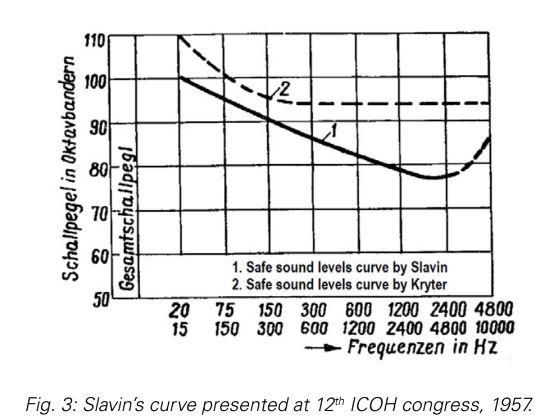
Slavin participated at the 12th ICOH Congress which took place in Helsinki, 30th June-5th July 1957, where he presented “Tentative Standards and Regulations for Restricting Noise in Industry” written in German. This Congress was very important to Slavin because his proposal on noise levels limits to workplaces was internationally known and according to him “Noises allowed by Soviet norms are close in their values to those reported at the Congress in the order of discussion by scientists from the USA ([Charles R.] Williams) and Japan ([Shiji] Katsuki)” (Slavin, 1957). Figure 3 (extracted from his paper) compares Slavin’s curve for safe sound levels and the Kryter’s criteria, the one suggested for workplaces in the US in the same year of 1957.
Slavin’s 1955 paper in Russian is not available on the Internet yet, so the author has to use the CIA translation into English (CIA, 1959) and one article published in “Noise Control” magazine by the Acoustical Society of America (ASA, 1959). An important contribution by Slavin is that he has defined three frequency intervals (including the low-frequencies band) to establish the industrial noise levels limits, as one can observe in Figure 4:
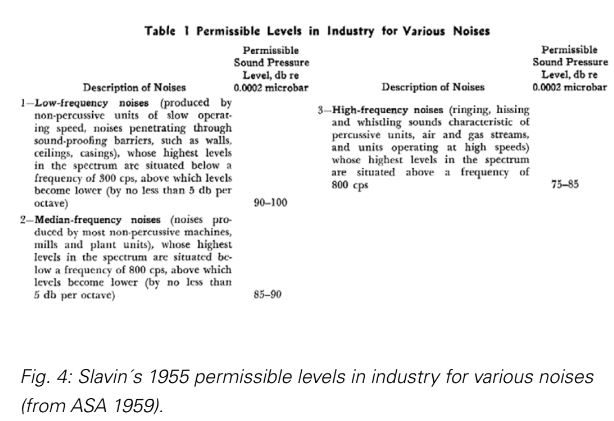
Despite the widespread use of the single metric dBA, it is clear from his writing that Slavin considered it was important to consider at least three separate frequency ranges. The table of Figure 4 was translated to a drawing as noise reference curves (See Figure 5). The curves in Figure 5(a) are difficult to understand, taken from CIA documents, and they had to have been simplified as one can see in Figure 5(b) taken from ASA paper.

Slavin’s work was mentioned widely in US technical publications; for example, the well-known American acoustician Karl David Kryter (1914-2013) highlighted that “Slavin states his contours are meant to be a practical balance between hearing conservation and necessary industrial noise conditions” (Kryter, 1970). According to Slavin, the Russian representatives at ISO presented his work about noise limits in workplaces. It is possible they did it in 1958 during discussions in ISO/TC-43 board but unfortunately, there is no other information available on the Internet yet, and his noise curve criterion was never finalized as a proposal.
Slavin died in January 1959, but his work was presented posthumously at Third International Congress on Acoustics held in Stuttgart. Slavin’s paper is not in ICA Proceedings but in an issue of Wireless World magazine of October 1959 (Wireless, 1959). Further information about Slavin’s work and life in acoustics can be found in a recent investigation published in “Noise Theory Practice” (Montano, 2020).
The Dawn of Sound Level Meters
To be able to implement any controls regarding limits to noise in the workplace it was important to be able to measure the noise accurately and that followed from the development of the sound level meter. Since 1880, with the advent of the telephone, countless devices, which were 100% electro-mechanical, were developed to measure hearing ability. They were generically called “audiometers” but at the time there was mention that audiometers ‘measured loudness or intensity,’ or “devices that can measure sound level,” it has to be kept in mind that before the acoustics terminology standardization in 1937, the term ‘intensity’ was incorrectly used as a synonym of ‘level.’ The audiometer in a modified version, evolved technologically to be used as a sound level meter, and the first fully electronic audiometer with valves was developed in Germany in 1919 and was called “Otoaudion” (Griessmann, 1921), but there are no bibliographical references that it was applied for sound measurements that were not related to audiometry.
The first reliable microphones for sound measurements
The condenser microphone
Edward Christopher Wente (1889–1972) working at Bell, designed and patented in 1917 the first condenser microphone “as a uniformly sensitive instrument for the absolute measurement of sound intensity” with: a wide bandwidth, undistorted and flat response, with real possibilities of calibration, electric circuit stability. The “Wente microphone” measures any kind of arbitrary noise in sound units and was capable of dealing with low levels of sound using an internal valve to amplify the voltage delivered by the membrane; for the first time, the acousticians had the ability to quantify sound level (Jones, 1931).
The moving-coil microphone from 40 Hz to 10 kHz
E. C. Wente and Albert Lauris Thuras (1888−1945) in 1931 designed a moving-coil microphone. This was aimed at improving the linearity of the device at low frequencies, and they found that by inserting a tube (identified as t in Figure 6) between the outside and the cavity behind the membrane (as if it were a Eustachian tube), there was the compensation of the pressure difference and, after calibration with a thermophone, extended frequency response was achieved, as one can observe the curve B’ in Figure 6 (Wente & Thuras, 1931).
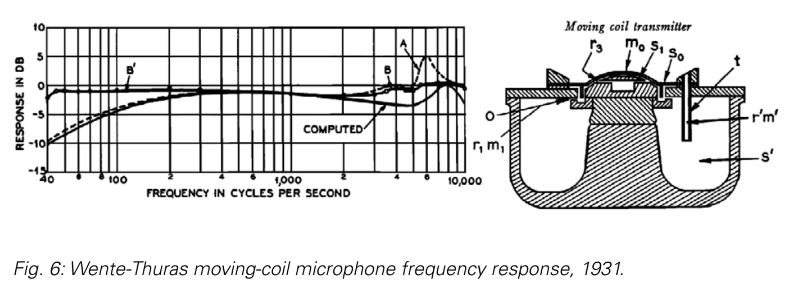
Another improvement introduced by this development was “This microphone has important practical advantages over the condenser transmitter in that the amplifier may be at some distance from the transmitter without loss in efficiency and in that no polarizing voltage is required” (Wente & Thuras, 1931).
European developments of early noise meters
In 1920 Archibald Montgomery Low (1886-1956), an English engineer and prolific writer and inventor, developed an electric/mechanic device to measure the sound intensity so-called “audiometer.” This was used in 1920, in a courtroom to measure and compare the noise level from motorcycles (Times, 1920). Its use was overtaken by the emergence of electronic sound meters, but it is possible to find some mentions of it until 1929.
Heinrich Georg Barkhausen (1880-1956) a German scientist designed an apparatus that could measure the sound levels in terms of sensation. In Barkhausen’s time, the sound pressure in Europe was measured in ‘Wien’ and to push this area onto a manageable scale, Barkhausen used the logarithm to base 2 ‘I would like to suggest the term ‘Phon’ for this volume unit,’ later in 1926 it was used in his noise meter (Barkhausen, 1926) and with that, the ‘Barkhausen-Phon’ was created. It is important to note that the “phon” concept as is used today is totally different from the Barkhausen-Phon.
This became popular and in 1928, a German engineering magazine held a “contest of ideas” (a competition) to reduce noise in cities using the Barkhausen noise meter (see Figure 7). This idea was replicated in some US newspapers but misspelled Barkhausen as “Backhausen”.
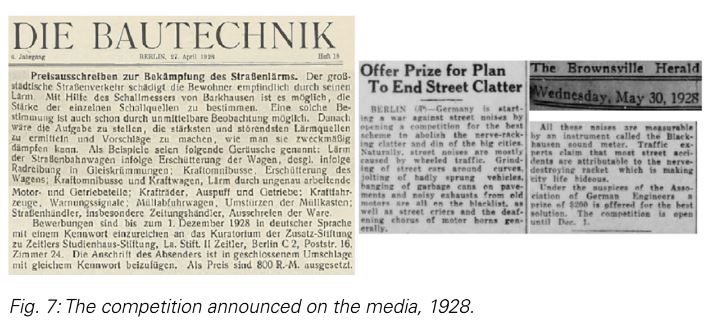
Following the use of a Barkhausen noise meter to measure occupational noise in 1929 and 1931, an improved version was commercialized under Siemens trademark. Barkhausen was undertaking research for Siemens in a similar way to Fletcher, who was researching for Bell. In 1933 Barkhausen published a paper that defined the concepts of the modern sound meters, this was just a few months before Fletcher and Munson published the hearing curves (Barkhausen, 1933).
Barkhausen’s concept of objective measurement was used for the earliest noise meter designed in England (Kaye, 1937), and in 1929 it was applied to conduct a noise survey of different sources, such as airplanes, car horns, isolation, material absorption, etc. (Times, 1930). There are also a number of publications on the use of Barkhausen’s noise meter for acoustic isolation measurement in some European countries until the 1950s (Ingerslev, 1952) and Japan (Ohya, 2017). In 1951, the background noise in the Royal Festival Hall, of London, was measured with a Barkhausen meter (Parkin et al, 1952). According to Roland Wittje (2016), Barkhausen visited the US and many other countries around the world promoting his meter.
Developments of early noise meters in the US
The first attempt to measure the noise levels with no mechanical parts was after the introduction of the full electric/electronic audiometers, in the US the portable “Western Electric 2-A” audiometer was sold in 1922 (Mills, 2011). The first mentions of the use of audiometers to measure the sound level for a variety of noise surveys are from 1926, when Edward Elway Free (1883-1939), Hiram Maxim, and other scientists were hired to measure the sound level of different US cities. Images of such measurements in 1926 are shown in Figure 8.
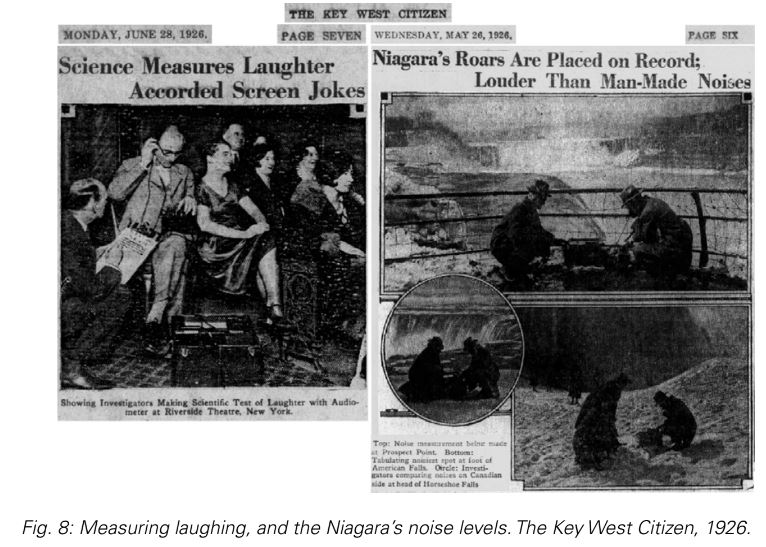
The meter was even used to judge a comedy competition as the joke which won for the loudest laughter was … “This joke received the largest unit measurement in audiometer test conducted with 26 topics: Jones: ‘Sorry, oh! Man, but my hen got loose and scratched up your garden.’ Smith: ‘That’s all right. My dog ate your hen.’ Jones: ‘Fine. I just ran over your dog’” (Key, 1926, p. 7).
- The develop of experimental noise meters
Kent E. Wooldridge, a graduate student of the University of Wisconsin, was selected by the Electric Railway Section of the Wisconsin Utilities Association to hold their 1925 fellowship. The subject assigned to him was the study of noise in the operation of electric cars and to make recommendations for reducing the car’s noise emissions and vibrations to improve comfort (Rood & Wooldridge, 1926).

Thomas Howell Laby (1880-1946) from Australia with his assistants, R. O. Cherry and R. Fullon (See Figure 10), and under a request by The Herald newspaper of Melbourne, conducted an amazing noise survey at Melbourne’s Cathedral Corner in May 1928: The sound captured by the microphone not only was used to measure the noise levels but also was transmitted nationally by 3LO radio station and recorded on gramophone (this pioneering work will be presented in a future article). Figure 10 shows their measuring system being transported from the university’s laboratory to the cathedral as well as one of the several charts that they obtained.
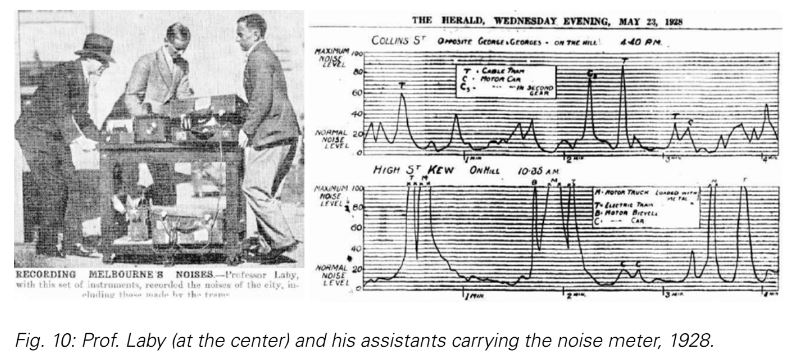
Jean-Fernand Cellerier (1870-1936) from France was the Director of Laboratoire d’Essais du Conservatoire National des Arts et Métiers and in 1931, was responsible for building a laboratory to measure the acoustic properties of materials: absorption, impedance, isolation, etc. In December 1931, Cellerier with his technical team presented a “sonde phonique” to measure the sound levels in cities and this was promoted by the Touring-Club de France. In 1935 they conducted a long-term noise survey in Paris with an improved and portable model of their “sonde phonique,” where they measured not only the noise emission produced by automobiles (see Figure 11) but also the noise produced by urban electricity distribution, and street noises in general. Figure 12 presents some pictures of noise surveys conducted by acousticians in different cities.
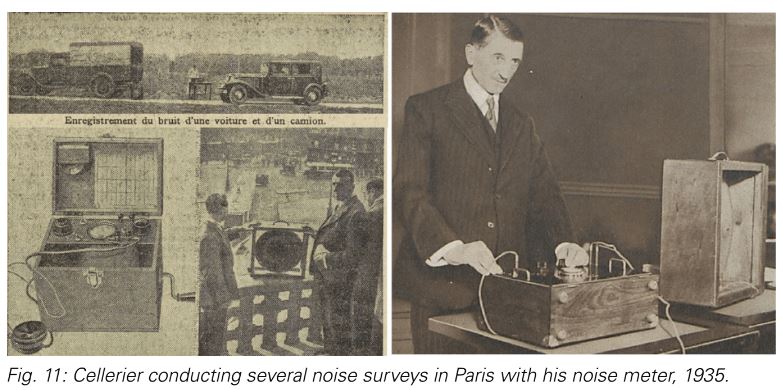
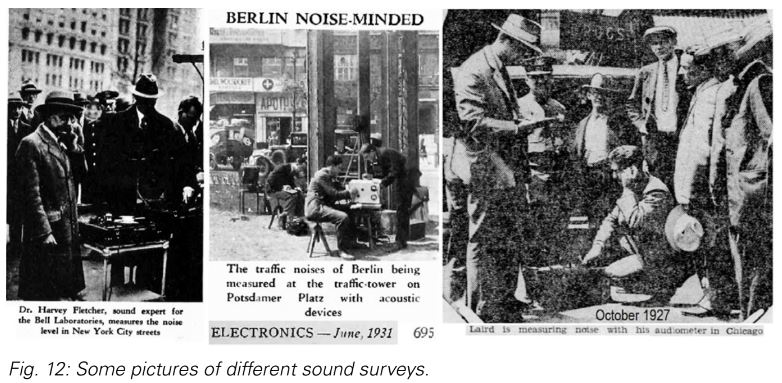
Acoustic engineer appears in history
The author was captivated as to when the “acoustic engineer” began to be mentioned as a profession, and to date, it appears that the first appearance in the media is from 1886 in France. Several articles comment on the work of an “ingénieur acousticien” (acoustic engineer) in developing improvements to a piano (Reyer, 1886), and an 1893 Parisian addresses guide lists to L. Lescuyer as an “ingénieur- acousticien” (Paris, 1893).
As far as could be found to date from searching US newspapers, the first mentions of “acoustic engineers” as a profession were in 1911 and linked to the work of improvements listening in courtrooms of many US cities. Jacob Mazer is the most commonly named as well as Frank E. Morton, who worked for American Steel as an “acoustic engineer.” Curiously Morton’s discipline comes from being a piano technician.
The new acoustic forensic tool: Sound on films
The first “talkie confession” in the US history of Criminology (and perhaps of the world) took place in a Philadelphia Courtroom in November 1929, just two years after the introduction of films with sound. Director Lemuel R. Schofield, of the Philadelphia Department of Public Safety, developed the idea of using talking motion pictures in a prosecuting case. Some newspapers in the US (and a few in Europe and Australia) commented on the first confession filmed with sound. Where it did get a lot of coverage was in magazines dedicated to the film industry, and it is their one can find a good explanation of how the recording was technically achieved. Figure 13 shows two photographs: one taken from Movie Makers magazine, the other from a Detroit newspaper article “How film camera and microphone were used to record the self-accused killer’s story of his deed” (Detroit, 1929).
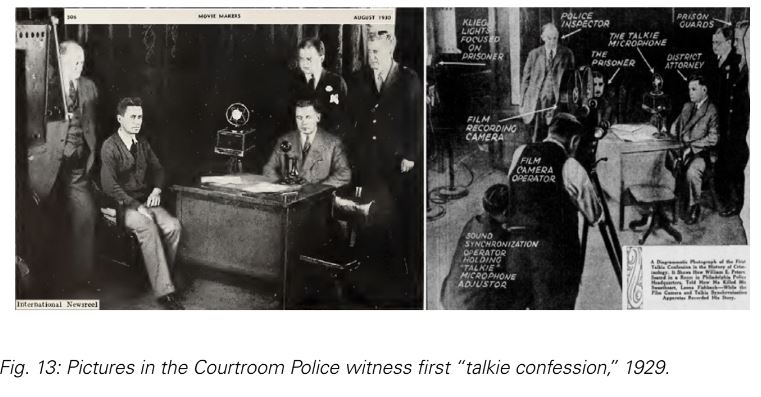
The creation of the Acoustical Society of America
The ASA was established in December 1928 and the history is already published (ASA, 2021). The author wondered what media coverage was given to the ASA media at that time. The first mentions that the author was able to find are from March and May 1929 which refers to the first ASA meeting and this news was replicated in dozens of US newspapers. Surprisingly, many of them mention the ASA as an anti-noise group, probably because the most highlighted work in newspapers was Laird’s studies on how noise affects people’s work productivity and how noise modifies the digestive system functioning.
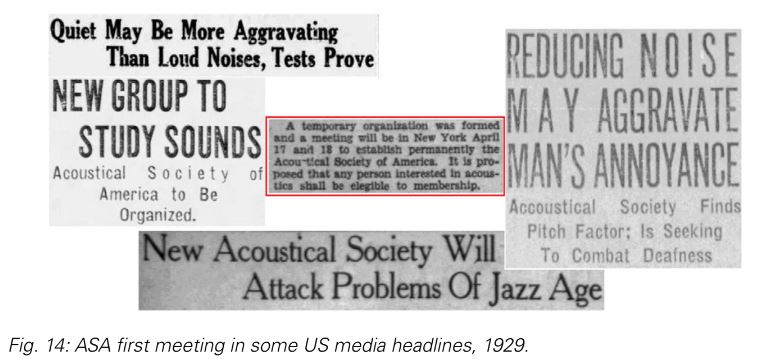
Abating the New York ash can ‘noise evil’
A modified version of the Western Electric 2-A audiometer was used in the well-known 1930 New York City noise survey, and as there is much information about this important research and investigation (Thompson, 2002), will be discussed in a later article. One part of that survey focused on identifying the most important urban noise sources. A “silent squadron” was created in July 1930, by the Committee to detect the ‘noise evil’ (New Britain Herald, 1930), and they undertook a specific investigation on the noise from the ash can and how to diminish it. Different ash can models were proposed and sound level measurements were made as the ash can was banging to the floor. Figure 15 shows one picture from “Images” magazine from Cairo, Egypt (Images, 1931; p.2), referring to the New York measurements.
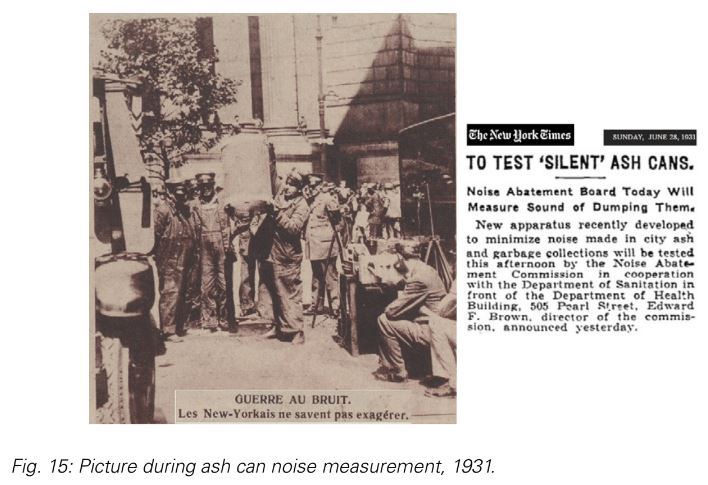
Conclusion
Most of the references in this article are from The Times of London, as well as Australian and US newspapers because they have a large accessible database. In future years when more historic documents from other countries become freely accessible, maybe this history will be updated. The noise section in the publication of the encyclopedia of the ILO of 1934, written by Carozzi, is possibly the draft that he presented in 1925 as he proposes to use the instruments of that time to analyze the noise in the workplaces. The update of the encyclopedia written by Caussé in 1938 has the technology that was used at that time, and one of his thoughts was “It is to be hoped that in the not far distant future the knowledge thus acquired will enable the risk to the worker’s health at present arising from industrial noise to be to a large extent reduced, if not entirely eliminated” (ILO, 1938).
Outside Germany, Barkhausen is more remembered for his research on low-level electrical signals and materials magnetic properties (the “magnetic Barkhausen effect” and the “magnetic Barkhausen noise”), than for his contributions to the specialty of sound level measurement. One can only speculate why his noise meter was not used more widely or why his theory on hearing curves after 1939 was not included in the acoustics textbooks.
However, this article is a tribute to the memory of I. I. Slavin because of his substantial contributions in the field of human hearing conservation; his scientific research resulted in legislation relating to limiting workplace notes that were the first in the world and used as the basis for similar legislation in many other countries.
Acknowledgments
The author wishes to thank Andrea Bauerdorff of Umweltbundesamt from Germany for providing several of Barkhausen’s papers; to Sonia and Irma of ILO Library; to Iuliia Rassoshenko of the Baltic State Technical University “VOENMEH,” for providing information about Slavin; also to Marion Burgess for assisting with the English expression, and to Eoin A. King and the Board of NNI magazine for the opportunity to publish.
Bibliography
-ASA (1959) Soviet Tentative Standards and Regulations for Restricting Noise in Industry. Noise control magazine. Published by Charles R. Williams.
https://asa.scitation.org/doi/10.1121/1.2369390
-ASA (2021) A Brief History of the Acoustical Society of America. ASA website.
-Barkhausen, H. (1926) Ein neuer Schallmesser für die Praxis. Zeitschrift für technische Physik 7 H. 12, S. 599 – 601. Leipzig.
-Brakhausen & Steudel (1933) Die lautstärke von geräuschen. Hochfrequenztechnik und ElektroAkustik. Elektroakustok 41, 115–116
-Beck, K.M.O.H.; Holtzmann, F. (1929) Lärmarbeit und Ohr. Eine klinische und experimentelle Untersuchung (= Arbeit und Gesundheit, H. 10), Berlin: Reimar Hobbing, 1929.
-Chicago Tribune, the (1871) The New Northwest. The Chicago Tribune. February 7, 1871.
-CIA (1959) Tentative sanitary standards and regulations for restricting noise in industry. CIA digital repository.
https://www.cia.gov/library/readingroom/docs/CIA-RPD80-00246A004500310001-7.pdf
-Detroit, the (1929) Slew his sweetheart, then made the first talkie confession. The Detroit Free Press, December 8, 1929, p. 4.
-Griessmann, B. (1921) The first model of the Otaudion. Neue Methoden zur Hörprüfung. Passow-Schaefers Beite. Hals-Nas. Ohrenheilk 1921;16.
-ILO (1934) Noise. Occupation and Health – Encyclopaedia of Hygiene, Pathology and Social Welfare. Volume II I-Z. International Labour Organization, Geneva, pp. 365-371.
-ILO (1938) Industrial noise (Physio-pathology). Occupation and Health. Encyclopedia’s supplement. International Labour Organization, Geneva, pp. 107-116.
-ILO (2020) History of the ILO. International Labour Organization
http://ilo.ch/global/about-the-ilo/history/lang–en/index.htm
-Images (1931) Images. Hebdomadaire égyptien paraissant le Dimanche. Cairo, Egypt, July 26, 1931.
https://gallica.bnf.fr/ark:/12148/bpt6k9106104x/f2.item.r=%22guerre%20au%20bruit%22new-yorkais
-Ingerslev, F. (1952) Acoustics in modern building practice. London: The architectural press.
-Jones, W.C. (1931) Condenser and Carbon Microphones-Their Construction. Bell-System-Technical-Journal. January, 1931, pp. 46-62.
https://worldradiohistory.com/Archive-Bell-System-Technical-Journal/30s/Bell-1931a.o.pdf
-Kryter, K D. (1970) The Effects of Noise on Man. Elsevier (Page 181, available at Google books)
-Mills, M. (2011). Deafening: Noise and the Engineering of Communication in the Telephone System. Grey Room, 118-143.
https://doi.org/10.1162/GREY_a_00028
-Montano, W. A. (2020) I. I. Slavin the forgotten Russian acoustician who defined in 1956 the noise levels limits for workplaces the first in world practice. Noise Theory and Practice. 2020; 2(6).
-Nature (1937) The First International Acoustical Conference. Nature 140, 370. 28 August 1937.
https://www.nature.com/articles/140370a0
-New Britain Daily Herald (1930) Volunteers seek outlawed noises. Ash can bangers aim of racket detector’s squad. Saturday, July 26, 1930, p. 10.
-Ohya, M (2017) The development history of sound level meter in Japan. Rion, Japan.
-Paris (1893) Paris addresses. E. Deussay Éditeur. France. 1893.
-Parkin, P.H.; Allen, W.A.; Purkis, H.J.; Scholes, W.E. (1952) The acoustics of the Royal Festival Hall, London. Department of Scientific and industrial research, Building research station, Garston, Walford, Herts, England.
-Peyser, A. (1910) Gewerbliche Erkrankungen und Verletzungen des Gehörs. ICOH heritage repository. Bruxells, 1910 (pp. 593 – 616).
http://repository.icohweb.org/gewerbliche-erkrankungen-und-verletzungen-des-gehors/
-Recorder (1928) Noise abatement. Progress in Melbourne. Recorder. Port Pirie, South Australia. Monday November 12, 1928, p. 4.
-Reyer, E. (1886) Journal des débats. France. November 28, 1886.
-Rood, J.T.; Wooldridge, K.E. (1926) Recording apparatus measures car noise. Electric railway journal. McGraw-Hill Publishing Co. September 11, 1926. Vol 68(11) pp. 413-416.
-Rubissow, G. A. (1937) “Talking paper” uses “electric eye”. Radio Craft Magazine. Volume IX(2) p. 75, August 1937.
https://worldradiohistory.com/Archive-Radio-Craft/1930s/Radio-Craft-1937-08.pdf
-Slavin, I.I. (1957) Gesetzliche Lärmnormativsystem in der Siwjetunion und ihre Wissenschaftliche Grundlagen. Helsinki 1957. ICOH heritage repository.
http://repository.icohweb.org/helsinki-1957/
-Slavin, I.I. (1959) A brief outline of works on noise research and noise control in the USSR for the period up to 1957. Acoustic Journal. Moscow, Russia.
http://www.akzh.ru/pdf/1959_2_221-230.pdf
-Thompson, E. (2002) The soundscape of modernity. Architectural Acoustics and the Culture of Listening in America, 1900–1933. The MIT Press. Cambridge, Mass.
-Times, The (1830) Kensington-Gardens. Letter to editor of The Times. Wednesday, July 14, 1830.
-Times, The (1920) Motor-cycle trials. Judging noise. Tuesday, July 20, 1920, p. 14.
-Times, The (1930) Study of noises. Experiments with airplanes. July 3, 1930, p. 11.
-Wente, E.C.; Thuras A.L. (1931) Moving-coil telephone receivers and microphones. JASA 3(44)
https://doi.org/10.1121/1.1915544
-Wireless World (1959) International Congress on Acoustics. Topics discussed at this year’s meeting in Stuttgart. Wireless World magazine October issue, p.428.
https://www.americanradiohistory.com/UK/Wireless-World/50s/Wireless-World-1959-10.pdf
-Wittje, R. (2016) The Age of Electroacoustics: Transforming Science and Sound. The MIT Press.


